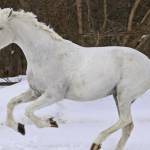Adjusting Horse Diets in Winter: Is It Necessary?

In winter, many horses get the chance to decompress, as owners and trainers decrease the intensity of training programs and allow horses to recover from the year’s work. No matter the plan for this time of year, it is good practice to take stock of a horse’s diet and ensure that all needs are being met with the changing season.
Temperature affects energy needs. Horses have a “lower critical temperature,” below which more energy is required to maintain proper body temperature. Clipped or partially clipped horses will have a higher lower critical temperature compared to those with full coats. For example, horses with a heavy winter coat may be quite comfortable down to 30° F (-1° C), whereas clipped or thin-coated horses may only be comfortable at temperatures above 60° F (15° C). Add in wind, rain, or snow and horses may need even more help staying warm. Some breeds, such as Thoroughbreds, may be more sensitive to the cold than others (think Welsh Ponies, Morgans, or Connemara Ponies). Age also plays a role, as older horses and some younger horses have a harder time regulating body temperature compared to other horses.
Kathleen Crandell, Ph.D., a nutritionist with Kentucky Equine Research, suggested keeping an eye on changing temperatures and adjusting forage intake accordingly. “Horses that are turned out for the winter should have access to a shelter with clean, dry bedding that blocks the wind. When a horse can lie down in a safe shelter, it can help conserve body heat.”
Consider changes in activity level. Training routines commonly change as temperatures drop. If this is the case, it is important to evaluate the diet to reflect changes in energy expenditure. For example, it may be appropriate to decrease concentrate and increase forage if training time dropped significantly or if the horse is given off the colder months entirely. In some cases, the concentrate can be reduced or eliminated and replaced with an appropriate amount of a ration balancer. In all cases, forage is still critical.
Monitor body condition. Familiarize yourself with body condition scoring. Practice on your own horse, and take profile photos each month to monitor changes. This is useful practice year-round but especially in cold weather when horses need extra energy to keep warm. If you notice a change in weight, consider an adjustment to type and amount of concentrate. Also think about the type of forage being fed. If it is low quality, is there a better quality available? If not, soaked beet pulp, hay cubes, and chopped forage are excellent options to add a fiber-based feedstuff to the diet that will provide highly digestible fiber and slow-release energy.
Check under blankets or rugs. Blankets or rugs will help a horse conserve body heat and energy. Remember, horses with clipped coats will need a blanket to stay sufficiently warm. Blankets help insulate the horse, conserving the energy it takes to keep warm, therefore supporting weight maintenance. Blanketing is very helpful for young foals and senior horses, as horses in both age groups have a harder time controlling body temperature. However, blanketing doesn’t mean “set it and forget it.” It is important to remove blankets and check body condition regularly. In this way, if a horse begins to lose (or even gain) too much weight, it should be noticed before the change becomes extreme. In the spring, if a horse has to spend time getting back to ideal weight to support the competition season, it may take longer to get back to peak condition.*
Increase forage and water as temperatures drop. Horses ferment the fibrous fraction of forage in the cecum of the hindgut. A by-product of fermentation is heat that can be used to help keep horses warm. Plenty of good-quality forage will help keep the internal furnace fueled. Concentrate will not have the same effect. Forage alternatives, such as soaked beet pulp, hay cubes or hay pellets, are also suitable options, especially for horses with compromised teeth.
With an increase in forage comes an increase in the need for water. Encouraging horses to drink in the winter can be a challenge. One study evaluated the effect of water temperature on intake and found that ponies drank 38-41% more water when all the water sources were warmed compared to near-freezing water.** Insulated or heated buckets or stock tank heaters, when installed properly, can be useful during cold snaps. Remember to keep the water clean, have plenty available for each horse, and, if using heaters, to check them daily to ensure they are in good repair.
In addition, ensure enough sources of water are available if horses are turned out in a group. Keep a salt block accessible as well. Check water sources daily to ensure ice buildup does not prevent water consumption. Electrolytes are an excellent way to encourage water consumption and maintain hydration. Restore SR (Restore in Australia and other places) by Kentucky Equine Research is a scientifically proven, balanced electrolyte that can be top-dressed on feed or given orally via paste.
No matter the plan for your horses in winter, it is a good time to take stock of body condition, exercise plan and overall diet. A Kentucky Equine Research nutrition advisor can help ensure dietary balance at any time of year and offer guidance on any possible seasonal adjustments.
*Liburt, N.R., and Williams, C.A. 2008. To blanket or not to blanket? Rutgers Cooperative Extension Fact Sheet #FS1081.
**Kristula, M.A., and S.M. McDonnell, 1994. Drinking water temperature affects consumption of water during cold weather in ponies. Applied Animal Behavior Science 41(3-4):155-160.








